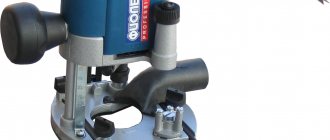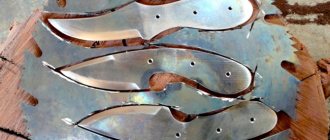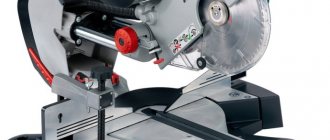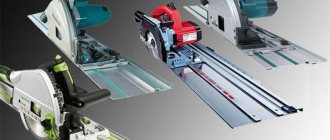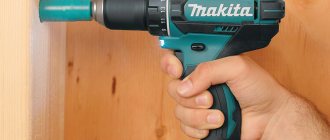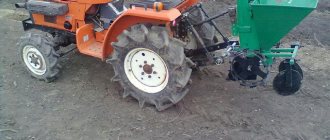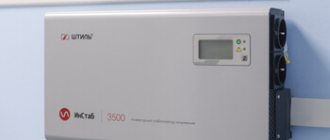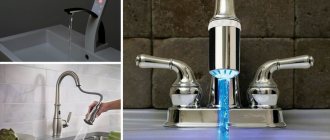A circular saw is a useful power tool for cutting lumber during repair or construction work. The main difference between a circular saw and an electric jigsaw is the shape and diameter of the saw. A circular saw can provide an even cut, without distortion to the sides, which will create a perpendicular edge.
Circular saws for wood are equipped with different accessories. Discs may differ in the number of teeth, the presence of additional soldering and slope, which determines the speed, quality and cleanliness of the cut.
There are several specifications of wheels designed specifically for a specific material. That is why you need to know the main characteristics and types. They will help you choose the right circle for specific tasks.
Marking
In order to freely navigate when choosing saw blades, you should first study the meaning of the marking. Today, the buyer has access to discs from manufacturers all over the world, but different manufacturers have different marking procedures, which can be a little confusing for the consumer at first.
In fact, there is nothing complicated in the different markings, and all the necessary data is necessarily indicated on each disc and packaging. The buyer just has to find them and evaluate them.
Marking example:
D200хd30х3, where
- D – external, “large” diameter, 200 mm,
- d – landing, “small” diameter, 30 mm,
- the remaining number 3 is the thickness of the disk 3 mm.
Sometimes, instead of the thickness of the disc, the number of teeth is indicated.
An example of such markings:
- 205x24Tx20, where
- 205 – outer diameter (205 mm),
- 24T – number of teeth, (24 teeth),
- 20 – bore diameter 20 mm.
Sometimes other markings are used. For example, a simple inscription 250 mm or with a diameter symbol “crossed out zero” 250.
Some manufacturers supplement the digital lines with pictures. For example, after line 335,64, 30/32 there are pictures with explanations. A disk is drawn with arrows indicating the outer diameter and the number 335, teeth and the number 64, the inner diameter with an adapter ring that allows the disk to be used on shafts with a landing diameter of both 30 mm and 32 mm.
The type of tool for which the disk is intended can be depicted - a manual or stationary circular saw.
The best mini circular saws
Makita HS301DWAE is suitable for cutting dense wood.
To work with small boards, you can use the following models of mini circular saws:
- Status CP90U - used for trimming wood, ceramics, metal, laminate and PVC.
- Makita HS301DWAE - the blade rotation speed does not exceed 1500 revolutions and therefore the model is not suitable for cutting dense wood.
- DIOLD DP-0.55 MF - is equipped with a 550 W motor, which allows you to work with thick bars.
Important! Even though miniature circular saws look cheap due to their small size, they are actually quite expensive.
The main parameters you should pay attention to when choosing
These are characteristics, if not met, the disc simply will not fit a particular instrument.
External diameter
On stationary circular saws, especially homemade ones, discs with a large difference in diameter can be used. Small for sawing thin workpieces, large for large-sized wood. In this case, it is advisable to have a set of different disks.
It is irrational and inconvenient to cut thin wood with a large-diameter disk - unnecessary loads on the engine due to the large lever of the disk, a cut that is too thick, and a large protrusion of the disk above the workpiece, which reduces the safety of sawing.
The maximum diameter on stationary circular saws is limited by the size of the slot for the disk or casing, if any.
Minimum – sufficient protrusion above the work table.
On manual circular saws there is no such variation in diameters - a disk of the same diameter that was installed at the factory is used. In exceptional cases, a disc 3-5 mm smaller in size may be suitable, but this will change an important characteristic - the depth of cut. A disk that is too large will simply not fit or will cling to the casing.
Landing diameter
During the Soviet era, only two mounting diameters were provided for stationary circular saws and trimmers - 32 mm and 56 mm. Today, manufacturers all over the world make landing shafts and discs of different sizes: 18 mm, 20 mm, 30 mm, etc.
However, the standards remain, although they have increased. And this is understandable - no backlash is allowed here. The disk must fit tightly on the shaft, otherwise it simply cannot work. A bore diameter that is too small will not allow the disk to fit onto the shaft, while a bore diameter that is too large will cause displacement, beating and vibrations that are incompatible with operation.
Sometimes adapter rings or washers are used to ensure compatibility between different diameters. For example, using a washer with an internal diameter of 32 mm and an external diameter of 56 mm, you can install a disk with a landing diameter of 56 mm on a landing shaft with a diameter of 32 mm.
A 1 mm thick adapter ring allows the use of a 32 mm disc on a 30 mm diameter shaft, etc.
Thickness
The parameter matters. Thin disks have a number of advantages and disadvantages over thicker ones. Advantages:
- saw faster
- with less noise
- make a thin cut with a minimum of sawdust waste.
The latter is especially important when sawing expensive wood. Sometimes only 2-3 mm determine how many, for example, bars will come out of the board - 5-6 when cutting with a thin disk or 4-5 with a thick cut.
A thin disk makes a cut 2-3 mm wide. Thick – 3-4 mm. Sometimes a large disk with a wide tooth set can make a cut 5-6 mm wide.
Disadvantages of thin disks:
- prone to bending, so sometimes the cut can turn out wavy,
- can quickly overheat, sometimes to the point of turning blue, which can damage the disk completely. Overheated disks begin to “wiggle” with different amplitudes, sometimes up to 10 mm or more.
Thicker and more massive disks are slower but more stable.
Variety
Two fundamentally different types of disks are used:
- Made entirely from cutting tool steel, they are called backed or solid.
- With soldered cutting teeth made of various durable alloys.
The first ones belong to the outgoing type. Widely used in times when there were no technologies for precise and durable soldering of carbide alloys. Nevertheless, monolithic disks retain a number of advantages:
- very long service life, it is limited only by the fact that over time, after many sharpenings, the diameter of the disk decreases to critical sizes,
- ease of sharpening and straightening teeth,
- possibility of changing the shape and sharpening angles of the tooth,
- no soldering, solid tooth strength.
Disadvantages - they require regular editing, sharpening and regrinding of the teeth, since they are inferior in strength to teeth made of carbide alloys.
They were not cheap, since not only the teeth, but the entire array are made of special tool steel.
In order to carry and hold cutting teeth made of hard alloys without wobbling or overheating, other, cheaper steels are suitable. They are used today on disks with soldered teeth.
The quality of such a disc largely depends on the composition of the hard alloys. Most manufacturers keep their ingredients secret. However, it is well known that the most durable were the old Soviet wheels with “Pobedit” teeth.
Today, tungsten carbide, cobalt and other elements are used in alloys. Simple, household discs are not particularly durable: they chip, the solder comes off, and quickly wears down to zero after several sharpenings due to their small size. But professional, expensive discs from brands with a good reputation can last a long time and require sharpening less often.
Number of teeth
The cleanliness of the cut primarily depends on the number of teeth. It is important that not only the number of teeth differs, for example, per 10 cm of circumference, but most importantly, their size. If there are many teeth, they are small in size. Small teeth cut slower and cleaner, and tear out less material.
The differences in the operation of a disk with a small number of large teeth and a large number of small teeth are very significant.
- When a coarse-fine-toothed disc operates, there is less friction and it is easier for the engine.
- The disk heats up less.
- Large sparse sawdust is formed.
- The disc cuts faster.
- At the exit, a large tooth can tear out pieces of material, especially on plywood, chipboard, etc.
- Circular stripes and marks from teeth may remain on the cut.
A disk with fine teeth and a large number of them produces fine sawdust.
- If the wood becomes hotter due to friction, it may burn.
- Requires a reserve of engine power, since friction can cause the disc to slow down.
- A small tooth at high speeds is less likely to tear the material at the outlet.
- The cut at high speeds is streak-free, clean, and looks like it has been polished.
For simple, quick cutting, discs with sparse, large teeth are better suited. For better cutting, for sawing diagonally and across the grain, a tooth with many small teeth is better suited.
We also recommend reading interesting articles about how to properly use a hand-held circular saw and techniques for even sawing with a circular saw.
Tooth geometry
All modern discs use two tooth shapes:
- "Eagle Beak"
- Straight pointed teeth.
The form of the first option is well tested, verified and calculated. The cutting tip of the tooth brought forward throws out sawdust. The void under the carbide tooth does not create friction, facilitates the movement of the disc, and reduces heating. Such discs are successfully used for longitudinal, diagonal and transverse cuts.
Pointed teeth, analogous to the teeth on a two-handled saw or a hand saw, are better at sawing wood crosswise. That's why today they can be found on miter saws, especially the older ones. They are very effective for this. This tooth shape is not suitable for longitudinal sawing - it creates strong friction, noise, the disc overheats, and the wood burns.
Sharpening angle
This indicator differs between different drives and manufacturers. The main difference is the positive and negative front sharpening angles.
Negative - the cutting edge of the tooth is tilted back, from the radius axis by 5-10 degrees. Used on special discs for plastic, metal, MDF, laminate, scoring discs, etc.
Positive - the tooth is inclined forward, from the radius axis by 10-20 degrees. The most popular option for standard discs for wood and other soft materials.
Other differences, top view of the tooth:
- A tooth with a straight edge, directly perpendicular to the cut. Enters the workpiece with its entire plane at once.
- A tooth with a triangular, beveled edge. Enters the material with the sharpest protruding edge first.
For flawless operation, the first option requires constantly sharp sharpening and sufficient engine power.
The second option is, by definition, sharper, since it first enters the material with a sharp edge. But such teeth are prone to chipping due to the heavy load on the thin tip.
Teeth sharpened to simulate a set pattern. After one (left-right), such teeth are sharpened with a small angle relative to the disk.
The most unpretentious discs are those with a simple straight edge. They take the impact load when entering the material with the entire plane, therefore they chip less. It is important that they are easier to sharpen even by hand on a diamond disc.
It is enough to maintain only one angle of positive forward tilt. Teeth with more complex, angular sharpening can only be sharpened on special machines that allow you to maintain all angles at the same time.
Sometimes there are discs with teeth of an unusual shape - “Kremlin wall”, alternating large and small teeth, etc. These constructive delights are bought for testing. Perhaps they find application somewhere, but not widely.
We recommend reading the guide on how to sharpen a circular saw blade yourself; in it we discussed in detail all the nuances and methods of sharpening circular saws.
By watching the video, you can understand how disks of one design or another behave in practice, and understand which one is better to choose for a specific purpose.
Other options
The cutouts on the disc are important. Metal expands when heated. Moreover, if it heats up evenly, it will simply increase slightly in size. But if, due to friction with wood, one part of the disk heats up and expands, while the other, closer to the center, remains cold, the disk is likely to warp. To prevent this from happening, compensation cuts are made.
In addition to the function of “thermal seams”, such cutouts reduce friction, vibration and noise, and promote cooling of the disk using air. The more serious the manufacturer, the more carefully the size, geometry, and location of such cutouts are verified and tested in laboratory conditions.
Types of disks
There are no commercially available universal discs that can handle all types of materials. The main difference is the shape of the cutting edge. Even for one type of raw material, like wood, there are several wheels on sale that are designed for hard and soft wood. Some are designed to work with soft wood (pine, fir, spruce) and hard wood (ash, beech, cherry).
An indicator of durability is the presence of pobedite or diamond tipping on the teeth. These are small pieces of carbide minerals (tungsten carbite) that are much harder than metal and wood.
Conventional steel wheels have a shorter service life and are prone to frequent wear of the cutting edge.
Metal monolithic models are made of carbon steel. The cutting edges are thermally hardened, which increases their density and hardness. Thanks to this, they do not become dull longer and remain suitable for normal work. If the edge is dull, it can be sharpened using stones or special emery machines. Much cheaper compared to Pobedit ones. The metal used for manufacturing must not be overheated. As the temperature rises, tempering of the steel may occur. This will cause the metal to become soft and practically unusable.
Models with soldering have higher productivity, since the linings are much harder compared to ordinary metal. They do not require additional sharpening, which is why they can last longer. But cannot be restored if damaged. Diamond and will win is afraid of overheating.
If the technique of working with the disk has been violated, the soldering may crack or chip, which will lead to complete inoperability.
If the soldering wear occurs, they can be sharpened. This requires an engraver with a diamond disc and additional polishing using a vulcanite wheel or felt with GOI paste.
Selecting a nozzle to solve a specific problem
Each disc packaging indicates its special purpose. Discs are often found for relatively universal purposes, for materials that are similar in structure and density. For example, for wood, chipboard, fiberboard, plywood.
There are no good “everything” discs. If the manufacturer claims that it is for wood, metal, concrete, etc., then in the end such an item will not cut anything.
For wood
For basic, regular cutting, discs with large, sparse teeth are well suited. For example, outer diameter 200 mm X 24 teeth. For clean, diagonal, cross-cutting, options with medium or fine frequent teeth are better suited.
For clean cutting of chipboard and laminate
For these materials, the smaller and more frequent the tooth, the less chipping and scoring there will be. However, even then there is no guarantee of cutting without damage. These materials are sawed on special machines with a second scoring disc that rotates in the opposite direction.
Using a regular circular saw, these materials can be sawed without damage with the above-mentioned disk, but with preliminary trimming of the cladding, or with the cut area covered with protective adhesive tape.
For aluminum
Metal discs are used. For example, for non-ferrous metals or thin steel. Such discs have fine teeth, a negative angle, and are made of special metal-cutting steel.
The best inexpensive circular saws for the home
There is no need to buy expensive circular saws for home use. Budget models are also suitable. The top best inexpensive saws include the following devices:
- Makita 5007N - is equipped with a powerful engine that provides wheel rotation speeds of up to 6000 rpm.
- DeWALT DWS510K is a powerful budget saw suitable for cutting dense bars and planks.
- Makita 5477NB - the disc spins up to 5500 rpm, which allows you to cut wood of any density.
The average cost of budget saws is 10-12 thousand rubles.
How to choose a miter saw
The difference between a miter saw and a regular circular saw is that it cuts primarily across the wood. Sometimes diagonally, rarely along the grain, for example, if you need to make cuts for a groove/tenon. Therefore, universal-purpose discs are suitable for it (for longitudinal and cross cutting, as on a regular circular saw).
Cross cutting blades will also work well. For example, old-style monolithic ones with straight, well-sharpened teeth.
Another difference from a circular saw is that the miter makes short cuts. Therefore, discs, as a rule, last longer than those on a circular disc.
A disc with a large, sparse tooth cuts faster, but can tear the material. The optimal number of teeth for trimming: for a disk with a diameter of 250 mm - about 40. 80-100 teeth for this diameter - on special disks for plastic, metal, etc.
Characteristics
There are two main indicators that you should pay attention to when purchasing.
Diameter is a characteristic that affects the speed of rotation of the motor shaft. The size of circular saws varies, and this changes the parameters of the wheel. The optimal ratio of size and speed can be presented in the tables:
| Diameter mm. | Rotation frequency |
| 80 | 23 800 |
| 100 | 19 100 |
| 120 | 15 900 |
| 250 | 7 600 |
| 350 | 6 300 |
As the diameter increases, the comfortable operating frequency always decreases. What you need to pay attention to when buying a tool. On a circular saw with a permissible diameter of 100 mm, it will not be possible to install an eightieth blade.
Each disc is designed for specific speeds allowed by the manufacturer. High speeds are the main cause of metal burnout, after which it changes its shape and becomes soft.
To find out the basic indicators suitable for working with equipment, you need to read the information on the disk. Next to the brand label, its main characteristics will be written:
- Diameter;
- Operating rotation speed;
- Additional information (low noise level, anti-temperature coating materials).
Rating of the best
Saw equipment is a popular (consumable) product. Therefore, there are many who want to occupy this niche with their low-quality goods. The problem is that counterfeit manufacturers may use reputable brand names.
It is safer to choose discs from reputable brands that have protection against counterfeiting (holograms on the packaging, website addresses where you can confirm the origin of the product, etc.).
If you don’t already have such a tool, then before purchasing, be sure to read a detailed article on how to choose a circular saw, and also check out the rating of the best circular saws for the home.
Best expensive
SMT, Italy. Cost from 2,400 to 10,000 rubles, depending on the size and number of teeth.
Original SMT products belong to the professional class, they cut efficiently, last a long time, and require sharpening less often.
This manufacturer is widely represented on sites where equipment for the mass consumer is sold. There are other manufacturers of professional disks; you should look for them on sites selling professional equipment. The prices for such products are high.
Middle price segment
Manufacturers of power tools often produce accessories for their products. At the same time, they are interested in their instrument having a good reputation. Therefore, saw blades of the same name as the tool are usually of good quality. These include: Bosch, Metabo, Zubr, Makita, Dewalt.
Prices from these manufacturers are comparable. More often, preference is given to the Bosch and Makita brands due to traditional German and Japanese quality and good reputation.
The best circular saws for quality and reliability
DeWALT DWE560 is one of the best circular saws.
Among the most reliable and high-quality models are the following:
- Interskol DP-190. The saw has a power of 1600 W, the diameter of the circle is 19 cm. Allows you to make cuts 60 mm deep.
- DeWALT DWE560. The device is equipped with a 1300 W motor. This allows you to cut any tree.
- BOSCH GKS 190. Cutting depth - 70 mm. Cuts both small and dense bars.
Additional Information! All listed models are equipped with soft start.
Marking of saw blades and its interpretation
All products currently produced usually display the logo and brand of the manufacturer. This is usually the largest and most striking element of the marking, which is important only to make it easier to remember the brand of the product you like.
Much more important information can be obtained from the remaining elements of the marking. The main dimensions of the product in millimeters must be depicted on the surface of the saw blades. For example,
140 x 2.5 x 20,
where 140 is the outer diameter of the circle, 2.5 is the thickness of the disk, 20 is the diameter of the mounting hole.
The second mandatory value displayed on the product is the maximum rotation speed at which it is possible to safely use the saw blade. It is measured in revolutions per minute, which the cutting tool shaft makes when rotating. For example,
n<6500 rpm.
In addition to this basic information, the surface may describe the area of application of the blade using words or pictograms, schematically depict the shape of the teeth, indicate the direction of rotation and indicate the speed at which different types of wood should be cut.
Criterias of choice
Disc diameter, mm - this parameter directly affects the depth of cut; it should not exceed the dimensions of the circular saw casing. On average it is 180 - 260 mm.
The seat diameter of the disk, mm , must coincide with the diameter of the spindle; a larger diameter can be adjusted using special adapter rings. The most common diameter is 30-32 mm.
Number of teeth - the more teeth, the cutting speed decreases, but the cleanliness of the cut becomes better. On average it varies from 40 to 60 pieces. Discs with fewer teeth are best used for soft wood, with more teeth for hard wood (plywood, chipboard).
The thickness of the disc is directly related to the width of the cut; the thicker it is, the greater the load it can withstand and the longer the service life. But there are also some disadvantages - this is the load on the saw itself and the amount of dust and sawdust.
Types of saw blades (monolithic and carbide) - monolithic is made from tool high-carbon steel, the price range is lower than that of carbide blades, but they must be periodically thinned and sharpened.
Carbide ones have reinforced brazing on each tooth made of cobalt and tungsten carbides. They are more durable and versatile for cutting other materials, such as laminate, plastic, aluminum. The downside is that sharpening is more difficult.
The best hand-held circular saws
The following manual circular saws are especially popular among buyers:
- Makita HS7601 - Used for vertical or 45 degree cuts only.
- Interskol DP-190/1600M is a budget model with soft start and power control.
- Makita 5008MG - uses a 1.5 kW engine, spins the disk up to 5500 rpm.
Many people face problems when purchasing a new circular saw. Before you buy such a tool, you need to understand what a circular saw is and which model to choose for your home.
